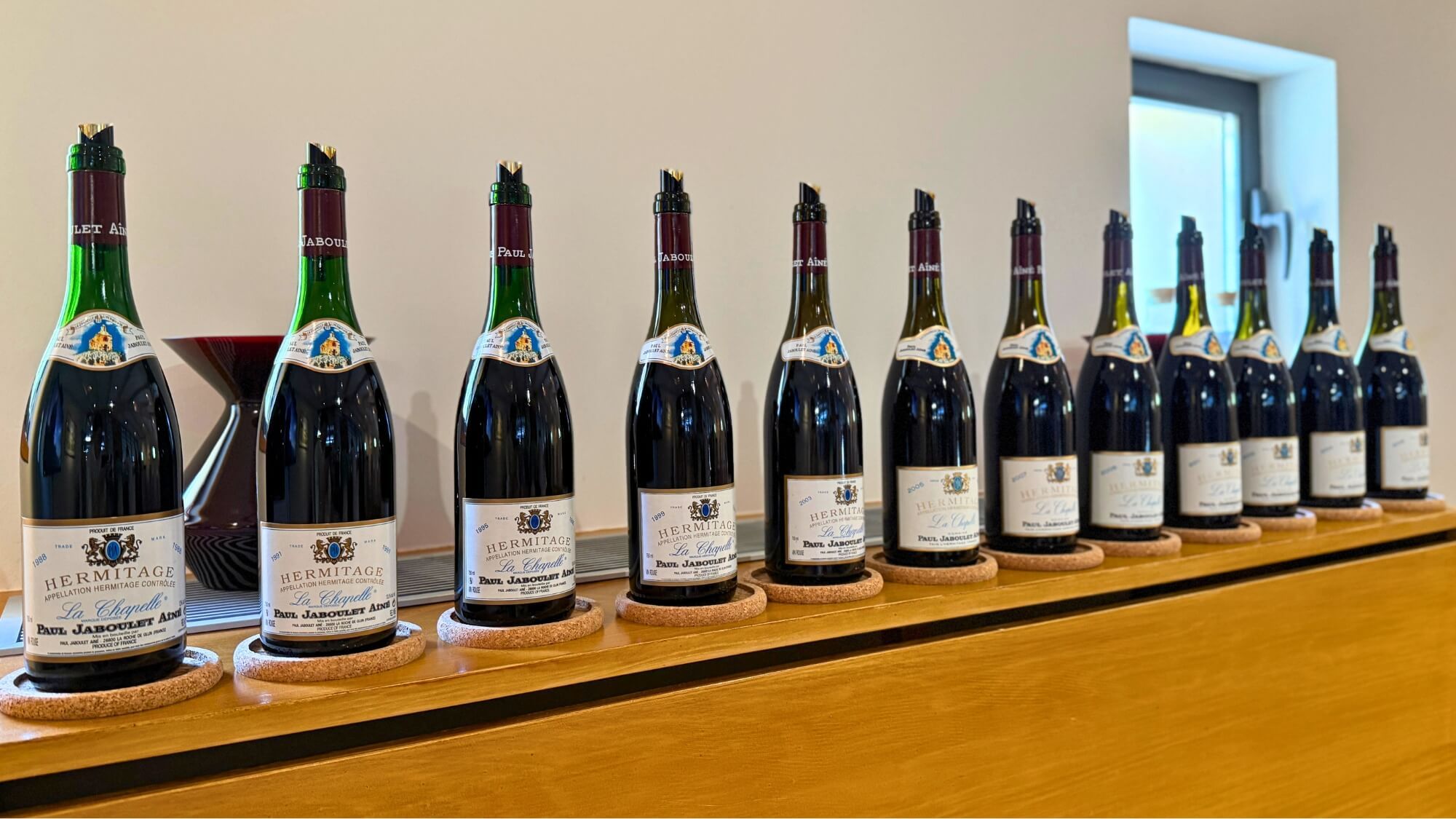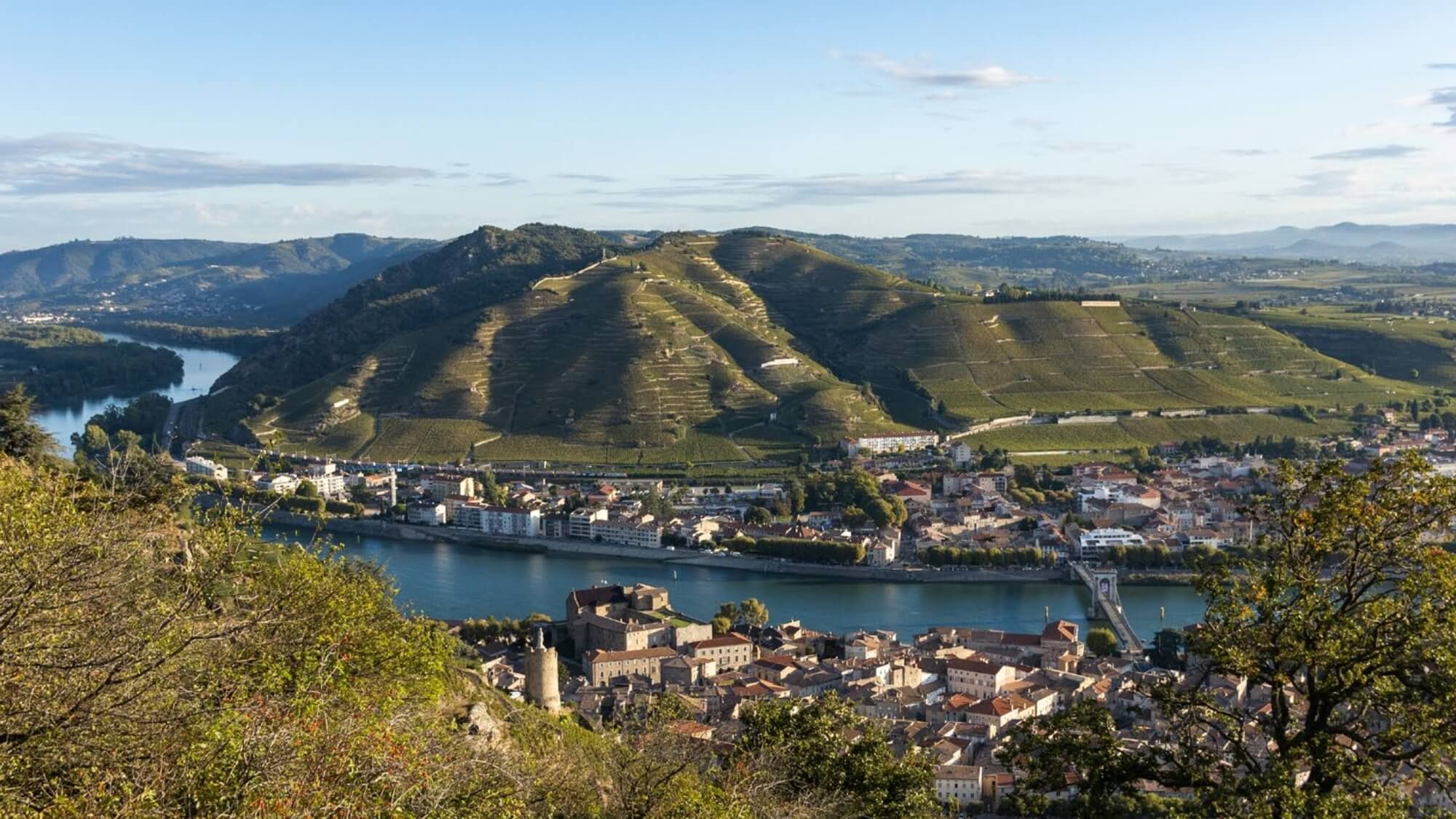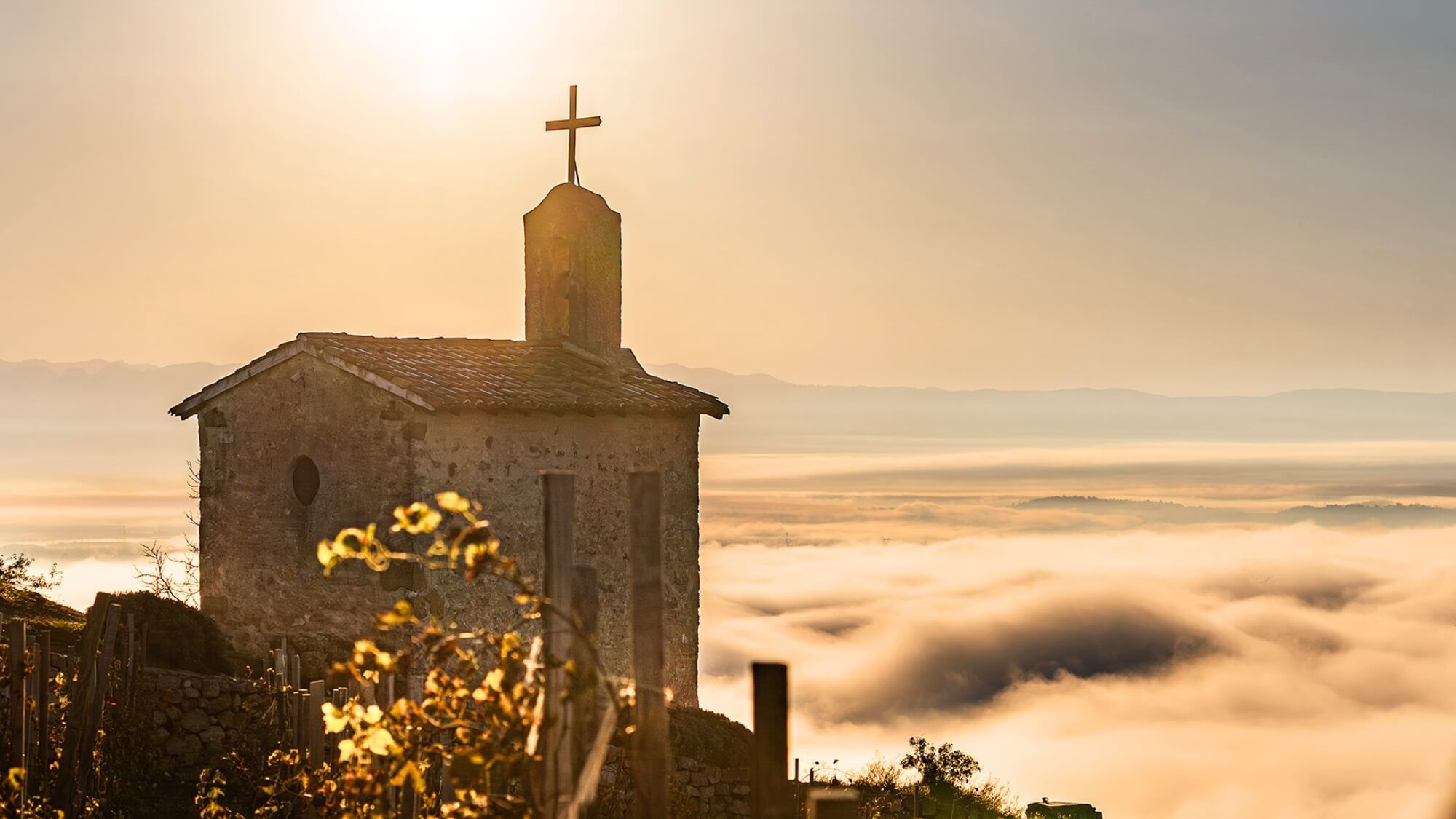AMA Vertical Tasting
Domaine de La Chapelle

AMA Snapshot of La Chapelle
Style profile: Powerful in structure, deeply mineral, slow to open, with remarkable aging potential.
Winemaking philosophy: A steadfast commitment to 100% destemming, preserving clarity of structure and purity of fruit.
Vineyard composition: The blend is primarily sourced from Méal, Bessards, Rocoules, and Greffieux (since the 2021 vintage, Greffieux is no longer included in the Grand Vin).
Blending philosophy: La Chapelle has always upheld the principle that “blending reigns supreme,” highlighting the harmony of multiple sites rather than the pursuit of a single-vineyard expression.
Signature vintages: 1961 remains the legendary benchmark; 1989, 1991, 2005, 2007, 2015, 2016, and 2022 are vintages I personally recommend exploring.
Historical turning point: Beginning with the 2021 vintage, La Chapelle stepped out of the Paul Jaboulet Aîné estate and was reestablished as Domaine de La Chapelle, with distribution through the Bordeaux Place system.
New-generation stylistic direction: While retaining its capacity for long aging, the recent vintages place greater emphasis on expressive fruit and seamless texture.

The Year I First Arrived in France
In 2011, I first arrived in France to study wine in Valence, a small town not far from Hermitage. One weekend, my mentor Antoine told me he wanted to take my mother and me to a very special place, though he kept it rather mysterious. We drove slowly along winding mountain roads, then continued on foot up a gentle path. After a few turns, a stone chapel suddenly appeared before our eyes.
At that time, I was just beginning my journey into the world of wine, and the little chapel meant nothing particular to me. But as my studies deepened, I came to realize that the first vineyard I had ever set foot on in France was in fact the sacred ground for Syrah lovers all over the world.

Later in 2020, Phydiasse and I returned to the Northern Rhône to film a series of appellation videos, and Hermitage was the very first one we shot. The feeling of standing atop that hill again is something I can still recall vividly.
Today, La Chapelle has become a familiar presence in my work as a wine critic. This past July, I was invited to a vertical tasting organized by Domaine de La Chapelle in Bordeaux. The estate carefully selected 14 representative vintages spanning 1964 to 2016, including luminous milestones in the estate’s history such as 2016, 2007, 1991, 1989, and 1964.
This tasting was not only a journey through time, but also a moment of deeper connection between myself and La Chapelle. I wanted to seize this opportunity to share with you how my relationship with La Chapelle evolved from a chance encounter to a rediscovery, and to trace, from my own perspective, the shifts in its style and quality over the decades.

In my view, the evolution of La Chapelle’s quality can be divided into three broad phases:
Phase One | Before the mid-1990s: The raw charm of traditional craftsmanship
This period saw several captivating vintages. Among them, the 1989 tasted at this vertical was outstanding, as was the frost-affected 1991, which shone brilliantly. Wines from this era occasionally show hints of Brettanomyces, yet far from diminishing the experience, this nuance adds a touch of wild allure.
Phase Two | Mid-1990s to 2004: A period under pressure and in decline
During these years, internal changes within the Jaboulet family and difficulties in management left their mark. Questions remain about the aging stability of certain vintages. Buyers should pay particular attention to storage conditions and the state of the cork.
Phase Three | From 2006 to the present: The road to revival
In 2006, the Frey family officially took over the estate, marking the beginning of La Chapelle’s revival.
To me, its true return to greatness began with the 2015 and 2016 vintages. That said, two earlier wines from the Frey family’s early stewardship deserve attention: 2005 and 2007. These vintages saw bolder use of oak, and while the wines may have seemed austere in youth, revisiting them today reveals a restrained elegance and a finely etched structure that exudes the composure and grandeur of “old money.”
The Art of Blending: Staying True to La Chapelle’s Origins
In today’s wine world, single-vineyard bottlings have almost become synonymous with “high quality.” Yet La Chapelle has steadfastly held to the belief that “blending reigns supreme.” This commitment resonates with an idea I often emphasize when presenting wines: only through blending can greater possibilities be unlocked.
The estate’s winemaker, Matthieu Carrara, told me that their group owns around 28 hectares of vines in Hermitage, making them by far the largest landholder on the hill. Yet only 7–8 hectares of the very best sites are used for La Chapelle. These vineyards lie on four of Hermitage’s most iconic terroirs:

- Méal: With its typical granite soils, this is the “heart” of La Chapelle, endowing the wine with its formidable structure, power, and monumental frame.
- Bessards: Perched on steep granite slopes, it lends a defined backbone and profound tannins, often finishing with a subtle saline note.
- Rocoules: A vineyard of dual character, where granite dominates the upper layers and pebbles the lower, offering both finesse and elegance.
- Greffieux: Once contributing spice and complexity to the blend, though since the 2021 vintage it has no longer been included in La Chapelle.
Each parcel is harvested and vinified separately, with blending taking place the following March. For Matthieu and his team, relying on a single vineyard would strip La Chapelle of its true identity. Only through blending, they believe, can the wine’s full character be revealed.
Biodynamics and Innovation: Learning Through Practice
La Chapelle obtained organic certification as early as 2016 and has practiced biodynamics for many years. Wine lovers are by now familiar with the “mystical aura” often associated with biodynamic growers, yet Matthieu’s perspective is strikingly down-to-earth.
He told me: “The only thing we can do is keep trying. After each attempt, we adjust according to the feedback from different parcels. Day after day, year after year, that is how we improve. There are no flashes of genius, and it is difficult to pinpoint a single step that determines quality.”

Take the 2025 vintage as an example: in a year marked by extreme precocity and severe drought, La Chapelle’s vines in Hermitage neither ripened too early nor lost their balance. Acidity remained relatively fresh, and alcohol levels were kept between 13.5–14.5%. What seemed almost impossible was in fact the result of years of biodynamic practice.
Beyond vineyard management, La Chapelle has also introduced a series of subtle refinements in its cellar work. In summary:
- The proportion of new oak has been kept below 15%, combined with about 30% neutral vessels (such as large foudres and egg-shaped concrete tanks), lending the wines a gentler structure.
- Malolactic fermentation is now carried out in inert containers, helping to preserve greater fruit purity and freshness.
- The aging period has been shortened to around 15 months, making the style more approachable compared to the traditional profile.

All these adjustments are not changes for the sake of change. Rather, they are intended to let the natural character of the fruit express itself to the fullest. After all, La Chapelle’s terroir is inherently endowed with structure and needs little adornment.
1961: The Legend Among Legends
In the long history of La Chapelle, the 1961 vintage is universally regarded as its moment of true apotheosis. Both the Jaboulet and Chave families agree that this year not only achieved the ultimate expression of Hermitage’s terroir but also marked the most iconic pinnacle in La Chapelle’s history.
The spring was warm, flowering was marked by rain, and what followed was near-perfect weather. The rainfall during flowering did reduce yields, but unintentionally created a natural concentration and intensity. Compared with La Chapelle today, the winemaking of that era was almost rudimentary: grapes were still crushed by foot, many stems were left in the vat, and the reliability of wild yeasts depended largely on chance. The élevage lasted as long as 18 months, carried out mostly in large vessels with little influence from small oak barrels. Yet none of this prevented the 1961 vintage from becoming a divine masterpiece, a year anointed by fate itself.
Winemaker Matthieu told me that whenever he tastes this wine, he is struck by its astonishing vitality. The fruit remains vivid and generous, layered with notes of deep forest and black truffle. There is no trace of decline; instead, the palate is supple yet noble, the structure intact, and above all it conveys a sense of the imtemporel – a timelessness that seems to transcend the very passage of years.

La Chapelle Blanc: A New Chapter in White
For a long time, La Chapelle Blanc was produced only in a handful of vintages—before 2024, merely three or four. Beginning with the 2024 vintage, however, the estate has decided to release La Chapelle Blanc every year. Unlike the better-known Chevalier de Stérimberg, La Chapelle Blanc is crafted only from the cœur de presse, the purest middle portion of the juice, with a far stricter selection, resulting in a total production of merely 2,000 to 3,000 bottles annually. The grapes come solely from two elevated sites, Maison Blanche and Muret, with Marsanne in dominant proportion, complemented by a small share of Roussanne.
The proportion of oak is carefully restrained to 20%, with only 10% new barrels. This is not technical conservatism, but rather a reflection of the team’s understanding of terroir energy. From my own tasting, La Chapelle Blanc already carries sufficient backbone; the winemaker does not seek to add weight, but instead to leave room for air and flow.

The Knight and the Chapel: Echoes of a Name
As I come to the close of this article, I would like to share a story behind the name La Chapelle—one I once mentioned in a video about the Hermitage appellation.
In the 13th century, a knight named Gaspard de Stérimberg returned from the Albigensian Crusade, weary and scarred by war. All he longed for was a place of peace to rest both body and soul. He petitioned King Louis VIII and his queen, Blanche of Castile, for permission to live in solitude on the high slopes above the left bank of the Rhône. There, he built a small chapel.
That chapel is the very same Chapelle de Saint-Christophe we see today. His retreat gave birth to the name of the appellation itself: in French, Hermitage means “a place of hermitage.”
Centuries later, Syrah has taken root here – refined itself, grown strong, and risen proud. And La Chapelle is no longer merely a bottle of wine; it has become a shrine for every winemaker and lover of Syrah.
Once it was the knight’s, once the hermit’s; now, it belongs to all who journey side by side with time.

